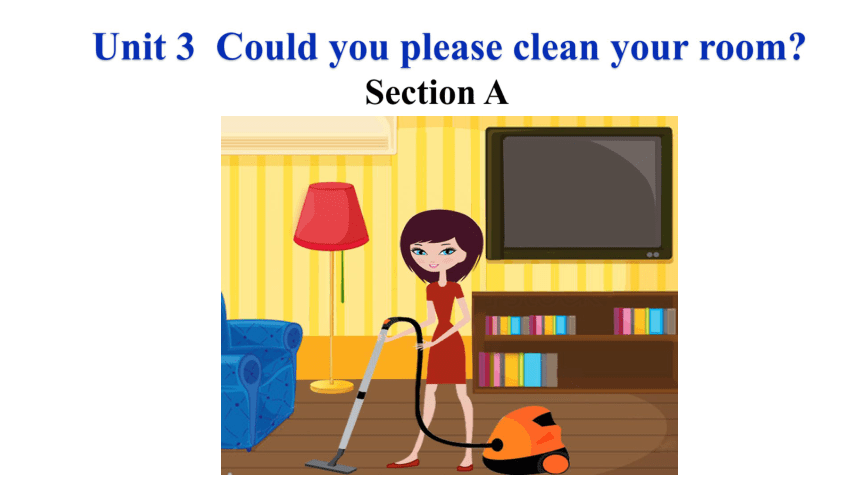
课件60张PPT。Unit 3 Could you please clean your room? Section A1. Peter,could you please take out the rubbish? (P17) (1)could是情态动词can的过去式,但在本句中could表示请求,语气比can委婉,此时没有时态的概念。 Could you please +动词原形...?意为“请你……好吗?”否定形式为:Could you please not +动词原形...? (2) take out意为 “取出;带出去”,属于“动词+副词”型短语,代词作宾语时,只能放在take与out之间。名词作宾语时放在out前后都可以。 【拓展】take away拿走;取走 take off起飞;脱下 take care of照顾;照看 take part in参加 take a walk散步2. Yes, because Mom will be back from shopping any minute now. (P18) any minute now 口语,意为 “随时;马上;在任何时刻”,表示事情有可能在极短的时间内发生或眼下就要发生。 minute还可以用second, moment, time等词替换。3. And she won't be happy if she sees this mess. (P18) mess可数名词,意为“杂乱;不整洁”。 常用短语:in a mess乱七八糟;make a mess弄得一团糟。 例:The children made a mess in the living room. 孩子们把起居室弄得很乱。 The room was in a terrible mess. 房间里脏乱不堪。4. I threw down my bag and went to the living room. (P19) throw(过去式为threw),“仍,掷”,既可用作及物动词,也可用作不及物动词。 throw down 扔下,随手丢下 throw at 向……扔去(恶意,带有攻击性) throw to 扔给……(不含恶意) 5. The minute I sat in front of the TV, my mom came over. (P19) (1) the minute/monent (that)...意为“一……就……”,后接时间状语从句,相当于as soon as...。 例:Please call me up the minute you get there. (2) 辨析:in front of 与 in the front of 例:Cathy was just sitting in the front of the car when she saw her friend Mary standing in front of the car. (3) come over 固定短语,意为“过来,顺便来访,拜访”,多指亲戚朋友或熟人之间的非正式的探望活动。后面加介词to,然后跟表示地点的名词作宾语。 例:When did you first come over to China? 你第一次来中国是什么时候?6. You watch TV all the time and never help out around the house. (P19) (1) all the time 意为“一直,总是”,多放于句末。 always 意为“一直,总是”,常位于be动词、情态动词、 助动词之后,实义动词之前。 (2) help out动词短语,表示在某人繁忙或遇到困难时“给予帮助”。help和out之间还可以加入具体的“人”。 如: He helped me out with my task. 他帮我完成了任务。7. I’m just as tired as you are! (P19) as ... as 意为 “和……一样” ,表示同级的比较。使用时要注意第一个as为副词,第二个as为连词,引导比较状语从句。 否定形式为:not as/so...as... 意为 “不如……” 如:This?film?is?as?interesting?as?that?one. 这部电影和那部电影一样有趣。8. For one week, she did not do any housework and neither did I. (P19) ?neither的用法 ①作代词,意为“两者都不”,常用作单数,与介词of连用,作主语时谓语动词用单数形式。 如:He?answered?neither?of?the?letters.? ②作形容词,意为“两者都不”,与单数可数名词连用。作主语时,谓语动词用单数。 如:Neither answer is right. 两个答案都不对。 ③作副词时,意为“也不”,常构成“neither+be动词/情态动词/助动词+主语”结构,用于表示上文的某种否定情况也适用于下文。此时neither可相当于nor。 如:She can't swim,and neither/nor can I. 她不会游泳,我也不会。 【拓展】 ... ...
~~ 您好,已阅读到文档的结尾了 ~~